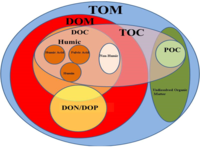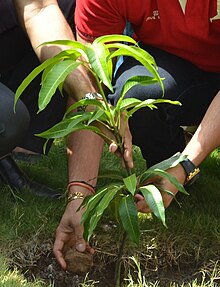Carbon dioxide removal (CDR), also known as negative CO2 emissions, is a process in which carbon dioxide gas (CO2) is removed from the atmosphere and sequestered for long periods of time. Similarly, greenhouse gas removal (GGR) or negative greenhouse gas emissions is the removal of greenhouse gases (GHGs) from the atmosphere by deliberate human activities, i.e., in addition to the removal that would occur via natural carbon cycle or atmospheric chemistry processes. In the context of net zero greenhouse gas emissions targets, CDR is increasingly integrated into climate policy, as a new element of mitigation strategies. CDR and GGR methods are also known as negative emissions technologies, (NET) and may be cheaper than preventing some agricultural greenhouse gas emissions.
CDR methods include afforestation, agricultural practices that sequester carbon in soils, bio-energy with carbon capture and storage, ocean fertilization, enhanced weathering, and direct air capture when combined with storage. To assess whether net negative emissions are achieved by a particular process, comprehensive life cycle analysis of the process must be performed.
A 2019 consensus report by the US National Academies of Sciences, Engineering, and Medicine concluded that using existing CDR methods at scales that can be safely and economically deployed, there is potential to remove and sequester up to 10 gigatons of carbon dioxide per year. This would offset greenhouse gas emissions at about a fifth of the rate at which they are being produced.
In 2021 the IPCC said that emission pathways that limit globally averaged warming to 1.5 °C or 2 °C by the year 2100 assume the use of CDR approaches in combination with emission reductions.
Definitions
| Part of a series on the |
| Carbon cycle |
|---|
 |
The Intergovernmental Panel on Climate Change defines CDR as:
Anthropogenic activities removing CO2 from the atmosphere and durably storing it in geological, terrestrial, or ocean reservoirs, or in products. It includes existing and potential anthropogenic enhancement of biological or geochemical sinks and direct air capture and storage, but excludes natural CO2 uptake not directly caused by human activities.
The U.S.-based National Academies of Sciences, Engineering, and Medicine (NASEM) uses the term "negative emissions technology" with a similar definition.
The concept of deliberately reducing the amount of CO2 in the atmosphere is often mistakenly classified with solar radiation management as a form of climate engineering and assumed to be intrinsically risky. In fact, CDR addresses the root cause of climate change and is part of strategies to reduce net emissions.
Concepts using similar terminology
CDR can be confused with carbon capture and storage (CCS), a process in which carbon dioxide is collected from point-sources such as gas-fired power plants, whose smokestacks emit CO2 in a concentrated stream. The CO2 is then compressed and sequestered or utilized. When used to sequester the carbon from a gas-fired power plant, CCS reduces emissions from continued use of the point source, but does not reduce the amount of carbon dioxide already in the atmosphere.
Potential for climate change mitigation
Using CDR in parallel with other efforts to reduce greenhouse gas emissions, such as deploying renewable energy, is likely to be less expensive and disruptive than using other efforts alone. A 2019 consensus study report by NASEM assessed the potential of all forms of CDR other than ocean fertilization that could be deployed safely and economically using current technologies, and estimated that they could remove up to 10 gigatons of CO2 per year if fully deployed worldwide. This is one-fifth of the 50 gigatons of CO2 emitted per year by human activities. In the IPCC's 2018 analysis of ways to limit climate change, all analyzed mitigation pathways that would prevent more than 1.5 °C of warming included CDR measures.
Some mitigation pathways propose achieving higher rates of CDR through massive deployment of one technology, however these pathways assume that hundreds of millions of hectares of cropland are converted to growing biofuel crops. Further research in the areas of direct air capture, geologic sequestration of carbon dioxide, and carbon mineralization could potentially yield technological advancements that make higher rates of CDR economically feasible.
The IPCC's 2018 report said that reliance on large-scale deployment of CDR would be a "major risk" to achieving the goal of less than 1.5 °C of warming, given the uncertainties in how quickly CDR can be deployed at scale. Strategies for mitigating climate change that rely less on CDR and more on sustainable use of energy carry less of this risk. The possibility of large-scale future CDR deployment has been described as a moral hazard, as it could lead to a reduction in near-term efforts to mitigate climate change. The 2019 NASEM report concludes:
Any argument to delay mitigation efforts because NETs will provide a backstop drastically misrepresents their current capacities and the likely pace of research progress.
Carbon sequestration
Forests, kelp beds, and other forms of plant life absorb carbon dioxide from the air as they grow, and bind it into biomass. As the use of plants as carbon sinks can be undone by events such as wildfires, the long-term reliability of these approaches has been questioned.
Carbon dioxide that has been removed from the atmosphere can also be stored in the Earth's crust by injecting it into the subsurface, or in the form of insoluble carbonate salts (mineral sequestration). This is because they are removing carbon from the atmosphere and sequestering it indefinitely and presumably for a considerable duration (thousands to millions of years).
Methods
Afforestation, reforestation, and forestry management
According to the International Union for Conservation of Nature: "Halting the loss and degradation of natural systems and promoting their restoration have the potential to contribute over one-third of the total climate change mitigation scientists say is required by 2030."
Forests are vital for human society, animals and plant species. This is because trees keep our air clean, regulate the local climate and provide a habitat for numerous species. Trees and plants convert carbon dioxide back into oxygen, using photosynthesis. They are important for regulating CO2 levels in the air, as they remove and store carbon from the air. Without them, the atmosphere would heat up quickly and destabilise the climate.
Biosequestration
Biosequestration is the capture and storage of the atmospheric greenhouse gas carbon dioxide by continual or enhanced biological processes. This form of carbon sequestration occurs through increased rates of photosynthesis via land-use practices such as reforestation, sustainable forest management, and genetic engineering. The SALK Harnessing Plants Initiative led by Joanne Chory is an example of an enhanced photosynthesis initiative Carbon sequestration through biological processes affects the global carbon cycle.
Agricultural practices
Wetland restoration
Bioenergy with carbon capture & storage
Bioenergy with carbon capture and storage (BECCS) is the process of extracting bioenergy from biomass and capturing and storing the carbon, thereby removing it from the atmosphere. The carbon in the biomass comes from the greenhouse gas carbon dioxide (CO2) which is extracted from the atmosphere by the biomass when it grows. Energy is extracted in useful forms (electricity, heat, biofuels, etc.) as the biomass is utilized through combustion, fermentation, pyrolysis or other conversion methods. Some of the carbon in the biomass is converted to CO2 or biochar which can then be stored by geologic sequestration or land application, respectively, enabling carbon dioxide removal (CDR) and making BECCS a negative emissions technology (NET).
The IPCC Fifth Assessment Report by the Intergovernmental Panel on Climate Change (IPCC), suggests a potential range of negative emissions from BECCS of 0 to 22 gigatonnes per year. As of 2019, five facilities around the world were actively using BECCS technologies and were capturing approximately 1.5 million tonnes per year of CO2. Wide deployment of BECCS is constrained by cost and availability of biomass.Biochar
Biochar is created by the pyrolysis of biomass, and is under investigation as a method of carbon sequestration. Biochar is a charcoal that is used for agricultural purposes which also aids in carbon sequestration, the capture or hold of carbon. It is created using a process called pyrolysis, which is basically the act of high temperature heating biomass in an environment with low oxygen levels. What remains is a material known as char, similar to charcoal but is made through a sustainable process, thus the use of biomass. Biomass is organic matter produced by living organisms or recently living organisms, most commonly plants or plant based material. A study done by the UK Biochar Research Center has stated that, on a conservative level, biochar can store 1 gigaton of carbon per year. With greater effort in marketing and acceptance of biochar, the benefit could be the storage of 5–9 gigatons per year of carbon in biochar soils.
Enhanced weathering
Enhanced weathering is a chemical approach to remove carbon dioxide involving land- or ocean-based techniques. One example of a land-based enhanced weathering technique is in-situ carbonation of silicates. Ultramafic rock, for example, has the potential to store from hundreds to thousands of years' worth of CO2 emissions, according to estimates. Ocean-based techniques involve alkalinity enhancement, such as grinding, dispersing, and dissolving olivine, limestone, silicates, or calcium hydroxide to address ocean acidification and CO2 sequestration. One example of a research project on the feasibility of enhanced weathering is the CarbFix project in Iceland.
Direct air capture
Direct air capture (DAC) is a process of capturing carbon dioxide (CO2) directly from the ambient air (as opposed to capturing from point sources, such as a cement factory or biomass power plant) and generating a concentrated stream of CO2 for sequestration or utilization or production of carbon-neutral fuel and windgas. Carbon dioxide removal is achieved when ambient air makes contact with chemical media, typically an aqueous alkaline solvent or sorbents. These chemical media are subsequently stripped of CO2 through the application of energy (namely heat), resulting in a CO2 stream that can undergo dehydration and compression, while simultaneously regenerating the chemical media for reuse.
DAC was suggested in 1999 and is still in development, though several commercial plants are in operation or planning across Europe and the US. Large-scale DAC deployment may be accelerated when connected with economical use cases, or policy incentives.
DAC is not an alternative to traditional, point-source carbon capture and storage (CCS), but can be used to manage emissions from distributed sources, like exhaust fumes from cars. When combined with long-term storage of CO2, DAC can act as a carbon dioxide removal tool, although as of 2021 it is not profitable because the cost per tonne of carbon dioxide is several times the carbon price.Ocean fertilization
Issues
Economic issues
A crucial issue for CDR is the cost, which differs substantially among the different methods: some of these are not sufficiently developed to perform cost assessments. In 2021 DAC cost from $250 to $600 per tonne, compared to less than $50 for most reforestation. In early 2021 the EU carbon price was slightly over $50. However the value of BECCS and CDR generally in integrated assessment models in the long term is highly dependent on the discount rate.
On 21 January 2021, Elon Musk announced he was donating $100m for a prize for best carbon capture technology.
Other issues
CDR faces issues common to all forms of climate engineering, including moral hazard.
Removal of other greenhouse gases
Although some researchers have suggested methods for removing methane, others say that nitrous oxide would be a better subject for research due to its longer lifetime in the atmosphere.





